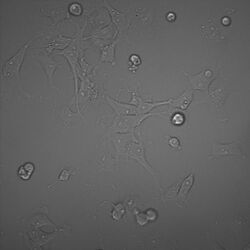Biology:COS cells
COS are fibroblast-like cell lines derived from monkey kidney tissue. COS cells are obtained by immortalizing CV-1 cells[1] with a version of the SV40 virus that can produce large T antigen but has a defect in genomic replication.[2] The CV-1 cell line in turn was derived from the kidney of the African green monkey.[3]
The acronym "COS" is derived from the cells being CV-1 (simian) in Origin, and carrying the SV40 genetic material.[2] Three COS lines were created (COS-1, COS-3 and COS-7), of which two are commonly used (COS-1 and COS-7).
Applications
The COS cell lines are often used by biologists when studying the monkey virus SV40. Cells from these lines are also often transfected to produce recombinant proteins for molecular biology, biochemistry, and cell biology experiments.[4]
When an expression construct with an SV40 origin of replication is introduced into COS cells, the vector can be replicated substantially by the large T antigen. These COS cells are genetically modified to produce the T antigen from their own genome.[4][5]
References
- ↑ "Infection of human and simian tissue cultures with rous sarcoma virus". Proc. Natl. Acad. Sci. U.S.A. 52 (1): 53–9. July 1964. doi:10.1073/pnas.52.1.53. PMID 14192657. Bibcode: 1964PNAS...52...53J.
- ↑ 2.0 2.1 Gluzman Y (January 1981). "SV40-transformed simian cells support the replication of early SV40 mutants". Cell 23 (1): 175–82. doi:10.1016/0092-8674(81)90282-8. PMID 6260373.
- ↑ Fanelli, Alex (2016). "COS-7 cell line: Origin and Characteristics". http://www.cos-7.com/.
- ↑ 4.0 4.1 Aruffo, A (November 2002). "Transient expression of proteins using COS cells". Curr Protoc Mol Biol Chapter 16: Unit 16.12. doi:10.1002/0471142727.mb1612s60. ISBN 0471142727. PMID 18265298.
- ↑ WEINANDER, Rolf (1995). "Heterologous expression of rat liver microsomal glutathione transferase in simian COS cells and Escherichia coli". Biochem. J. 311 (3): 861–866. doi:10.1042/bj3110861. PMID 7487942.
External links
 |


